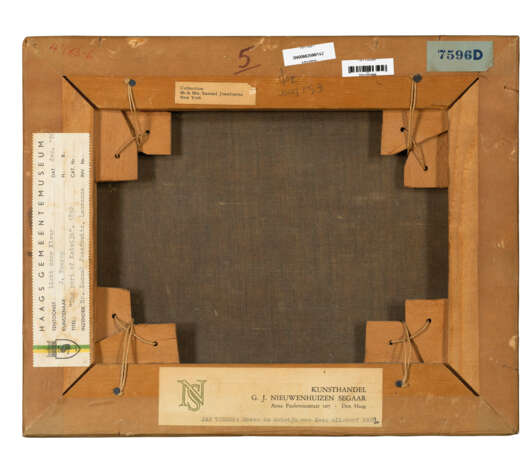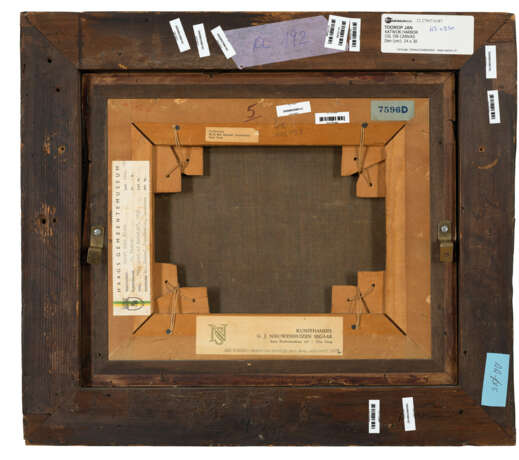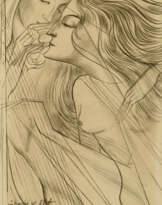ID 1051760
Lot 429 | Johannes Theodorus Toorop (1858-1928)
Valeur estimée
€ 150 000 – 250 000
Uitmonding van den Rijn ou Le Port de Katwijk
signé et daté ‘Toorop 98’ (en bas à gauche)
huile et graphite sur toile
25 x 30.8 cm.
Peint en 1898
signed and dated 'Toorop 98' (lower left)
oil and pencil on canvas
9 7⁄8 x 12 in.
Painted in 1898
Provenance
Kunsthandel G. J. Nieuwenhuizen Segaar, La Haye.
Sam Josefowitz, Pully (acquis auprès de celle-ci vers 1952).
Puis par descendance aux propriétaires actuels.
Literature
J. Sutter, Les Néo-Impressionnistes, Neuchâtel, 1970, p. 183 (illustré en couleurs; daté '1892').
G. van Wezel, Jan Toorop, Zang der tijden, Zwolle, 2016, p. 130, no. 219 (illustré en couleurs).
Exhibited
Dallas, Museum of Fine Arts, The Outline and the Dot, Two Aspect of Post-impressionism, mars 1962, no. 40.
La Haye, Gemeentemuseum, Licht door kleur, Nederlandse luministen, décembre 1976-février 1977, p. 39, no. 78 (daté '1892').
Further details
Aux côtés de Vincent Van Gogh, de Piet Mondrian et de Kees van Dongen, Jan Toorop fait partie des rares artistes néerlandais du tournant du XXe siècle à jouir d’une réputation et reconnaissance internationale. Né sur l’île de Java, alors colonie du royaume des Pays-Bas, il rejoint le continent dès 1869 pour faire ses études à Leiden, La Haye et Delft. Il suit ensuite, à partir de 1880, les cours de l’Académie Royale des Beaux-Arts d’Amsterdam.
En 1882, Toorop s’installe à Bruxelles qui est alors un centre majeur de développement des mouvements d’Avant-Garde, tant sur le plan des arts plastiques, de la musique que de la littérature. C’est à Bruxelles, en réaction à l’académisme, qu’une poignée d’artistes soucieux de se faire connaître et de pouvoir exposer librement, créent le groupe Les XX. Fondé en 1883 par Octave Maus, Théo van Rysselberghe, James Ensor et Fernand Khnopff entre autres, les XX réunit, comme son nom l’indique, vingt artistes fondateurs et organisent annuellement une exposition de leurs œuvres tout en prenant soin d’y inviter des artistes des Avant-Gardes étrangères. Toorop se rapproche dès le début de ces artistes et sera officiellement “vingtiste” dès 1885.
Ces nombreux contacts avec les artistes d’avant-garde libèrent chez Toorop une force créatrice importante, lui qui peint alors plus dans un style emprunt à Gustave Courbet et aux autres artistes naturalistes français. C’est au sein des XX qu’il découvre la technique divisionniste de Georges Seurat - invité des XX en 1887, 1889, 1891 et 1892; technique qu’il fera sienne dès 1888, et ce pendant quelques années, avec une grande habileté. Rapidement, son style évolue à nouveau et se trouve empreint d’une dimension symboliste. Il s’installe alors dans le village de pêcheurs de Katwijk aan Zee. C’est là qu’il peint la présente œuvre.
Pour les pointillistes, dont Toorop fut l’un des pionniers hors France, la mer était un sujet idéal. Les reflets puissants de l'eau, de la lumière et du ciel les ont incités à utiliser de manière optimale leur méthode de pointillisme tant appréciée. Dans ce tableau, Toorop a fait un usage exubérant des jeux de lumière et de couleur qu'il a observés aux écluses de Katwijk. Le bateau se reflète dans l'eau scintillante avec d'innombrables taches de couleur. Dans la technique picturale pointilliste de Toorop, les points servent non seulement à créer de la couleur par un mélange optique, mais aussi à dépeindre une atmosphère particulière et à capturer la lumière.
À partir de 1900, Toorop se tourne vers l'Art nouveau, puis se convertit au catholicisme et commence à produire des œuvres au caractère plus religieuses. Ses œuvres pointillistes, telle cette vue du port de Katwijk, sont ainsi aussi minutieuses que rares.
Alongside Vincent Van Gogh, Piet Mondrian and Kees van Dongen, Jan Toorop is one of the few Dutch artists of the turn of the 20th century to enjoy international recognition. Born on the island of Java, then a colony of the Kingdom of the Netherlands, he moved to the mainland in 1869 to study in Leiden, The Hague and Delft. From 1880 onwards, he studied at the Royal Academy of Fine Arts in Amsterdam.
In 1882, Toorop moved to Brussels, a major centre for the development of avant-garde movements in the visual arts, music and literature. It was in Brussels, in reaction to academicism, that a handful of artists, anxious to make themselves known and to be able to exhibit freely, created the group Les XX. Founded in 1883 by Octave Maus, Théo van Rysselberghe, James Ensor and Fernand Khnopff among others, Les XX brought together, as its name suggests, twenty founding artists and organised an annual exhibition of their work, taking care to invite artists from the foreign avant-garde. Toorop was close to these artists from the outset and was officially a "vingtiste" from 1885 onward. These numerous contacts with the avant-garde gave Toorop a great deal of creative freedom, and he painted more in a style borrowed from Gustave Courbet and other French naturalist artists. It was at the XX that he discovered the divisionist technique of Georges Seurat - a guest at the XX in 1887, 1889, 1891 and 1892 - it was a technique he adopted with great skill from 1888 onwards. His style soon evolved again, taking on a symbolist dimension. He moved to the fishing village of Katwijk aan Zee. It was here that he painted the present work
For the pointillists, of whom Toorop was one of the pioneers outside France, the sea was an ideal subject. The powerful reflections of water, light and sky encouraged them to make the best use of their much-loved pointillist method. In this painting, Toorop makes exuberant use of the play of light and colour he observed at the Katwijk locks. The boat is reflected in the sparkling water with countless splashes of colour. In Toorop's pointillist painting technique, the dots serve not only to create colour through optical mixing, but also to depict a particular atmosphere and capture light.
From 1900, Toorop turned to Art Nouveau, then converted to Catholicism and began to produce more religious works. His pointillist works, such as this view of the port of Katwijk, are as meticulous as they are rare.
| Artiste: | Jan Toorop (1858 - 1928) |
|---|---|
| Technique appliquée: | Huile sur toile |
| Genre: | Marine |
| Catégorie maison de vente aux enchères: | Peintures |
| Artiste: | Jan Toorop (1858 - 1928) |
|---|---|
| Technique appliquée: | Huile sur toile |
| Genre: | Marine |
| Catégorie maison de vente aux enchères: | Peintures |
| Adresse de l'enchère |
CHRISTIE'S 9 Avenue Matignon 75008 Paris France | ||||||||||||||
|---|---|---|---|---|---|---|---|---|---|---|---|---|---|---|---|
| Aperçu |
| ||||||||||||||
| Téléphone | +33 (0)1 40 76 85 85 | ||||||||||||||
| Fax | +33 (0)1 40 76 85 86 | ||||||||||||||
| Conditions d'utilisation | Conditions d'utilisation | ||||||||||||||
| transport |
Service postal Service de messagerie ramassage par vous-même | ||||||||||||||
| Modes de paiement |
Virement bancaire | ||||||||||||||
| Heures d'ouverture | Heures d'ouverture
|















